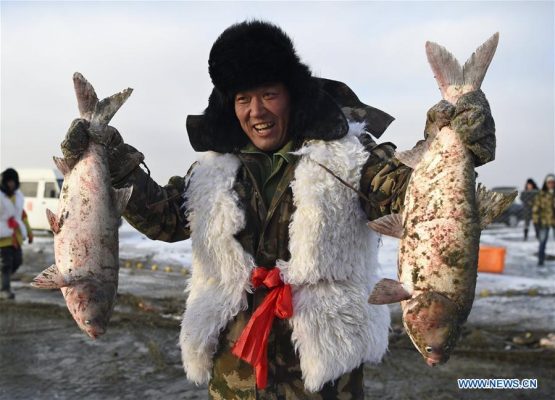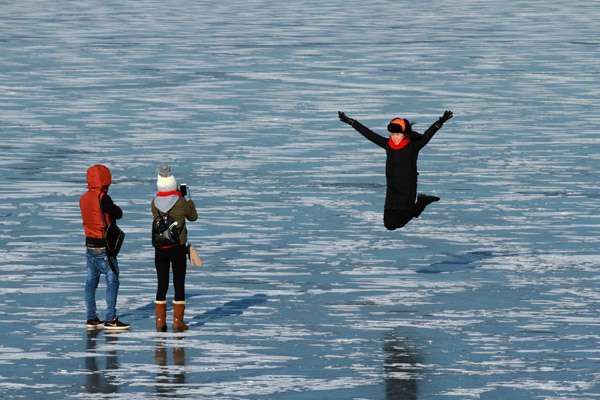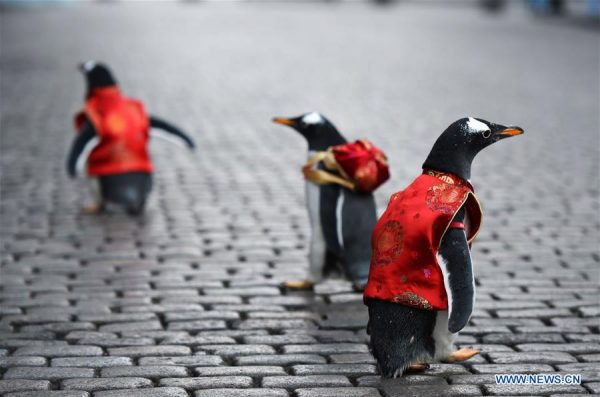
Tour operators offer travelers new experiences via self-driven vehicle rides
For long, trains, planes or buses have been the preferred modes of transport of travelers in China. Now, there’s another option: driving oneself around in four-wheelers, especially for sightseeing jaunts, long weekend getaways, short vacations, so on.
So much so tour operators are drawing up routes and itineraries to cater to this niche segment of road trip-lovers. For example, tourists to northeastern China, where snow and ice attractions abound, can drive along routes featuring hot springs, skiing and other winter pleasures.
One such tour started in Beijing on Jan 14. The eight-day driving extravaganza covering Heilongjiang province attracted 20 cars and more than 60 tourists from Beijing, Tianjin, Shanghai, Hebei and Sichuan.
They drove through three cities in the province-Harbin, Yichun and Heihe-before parking their cars on the China-Russia border. With official permits in pocket, they went beyond the border on a two-day trip to Blagoveshchensk in Russia’s Amurskaya region.
In Yichun, home to China’s largest red pine forests, they walked through the pristine forest and had close contact with some harmless animals like squirrels and sika deer.
“It was really an unforgettable memory,” said Wang Jinghui from Beijing, who took part in the tour. “I haven’t seen such heavy snow for many years. The fun in building snowmen together took us back to our childhood. The blue skies and fresh air were refreshing.”
On the tour, the first stop was the Wudalianchi Scenic Area in Heihe. It has a series of volcanic lakes with mineral springs. The area is regarded as a health resort and a scientific research site.
After tasting local delicacies, the team enjoyed the hot spring in the hotel. The next day, they drove to the car-testing base, which was founded for cars’ performance test in the winter in July 2015.
“Our club has a lot of opportunities for cooperation with automobile enterprises,” said the tour organizer Ge Rong, manager of Beijing Orange Joy Club. “As I know, Heihe has long and extremely cold winter, making it the first choice for car owners and car companies to test the vehicles’ performance in winter conditions.
“As a high-end club, most of our members pay attention to the quality of life. The good performance of their cars in snow and ice provided them an unprecedented driving experience.”

On the same day, they teamed up with local fishermen and went fishing in the frozen lake and enjoyed an all-fish feast. Various delicious fish dishes again gave them a memorable experience.
After driving 277 kilometers, they arrived at downtown Heihe, the famous Sino-Russian port.
They drove around the city that is full of Russian styles, reserving the last two days of the trip for the countryside on the other bank of the Heilong River.
“Almost everyone in the team has the experience of traveling abroad, but they still felt excited about crossing the border through the frozen river by bus in only 10 minutes,” Ge said. “Various activities were organized in Russia, including visits to museums, parties with local residents and shopping, which made the two-day trip colorful and memorable.”
Beijing Orange Joy Club boasts more than 70,000 high-end individual members. “Self-driving tours account for about one-third of our activities,” Ge said. “However, this is the first time the club has organized self-driven tours in extreme cold conditions in the Northeast.
“Both the route and accommodation arrangements were well received. I’ve decided to organize similar trips in the future so that more of our members can experience the thrills. I also hope someday we can drive our own cars to Russia across the Heihe-Blagoveshchensk Highway Bridge which is expected to open in 2019.”
Since 2016, Heilongjiang province has exploited its strengths like being home to China’s easternmost and northernmost points, and the river as international border, local forest, and developed several routes for those seeking to enjoy road-trip holidays.
The “Crossing Heihe, Pursue My Ultimate Expedition” campaign, promoted by the Heihe Tourism Development Commission in July 2017, has greatly enriched the city’s tourism.
“I was attracted by the route as I had practised driving here several times in the summer. I finally chose it after recommending some adjustments to vehicles, to meet the demands of our club members,” said Ge.
Zhou Lin, a travel researcher with the Heilongjiang Academy of Social Sciences, said: “Road trips have become a popular way to travel in China, along with package tours and independent tours. It’s an interesting way of experiencing new places.

“Self-driving tours will promote car sales, car rentals, vehicle insurance products and maintenance services. Such benefits to economy don’t derive from traditional tourism. They can create more employment opportunities in such industries.
“It’d be useful if tourism and communication networks as well as infrastructural facilities are bolstered so as to provide adequate and accurate information in a timely way.”
Neighboring Jilin province is gaining, too, according to the China Winter Tourism Development Report for 2017, which ranked the top Chinese cities and resorts in terms of their competitiveness in winter tourism.
A number of cities, resorts and events in Jilin were included in the top 10 lists, showing that the northeastern province has become one of the top winter tour destinations in the country.
In order to attract more self-driving tourists, authorities of some scenic spots have begun to offer various preferential policies.
Take Erhe Snow Town in Shulan city as an example. Famed for farm-based tourism, Erhe Snow Town, where snow falls for half a year and gets as deep as two meters, saw the number of photographers and visitors increase since 2012.
“From November 2016, in order to seize the opportunity provided by the rapid development of tourism, the municipal government began to develop the small village into a tourist resort,” said Yan Xue, deputy director of construction. “More than 40 million yuan ($6.35 million) has been put into improving the conditions at villagers’ houses for home-stays and building some new attractions.”
A house made of 30,000 corn cobs in traditional and typical Northeast rural house style was constructed last year, offering tourists some experience of traditional life in Northeast China.
Last year, nearly 30,000 travelers from nearby cities and some other provinces had visited the village, generating a revenue of 800,000 yuan, which is quite significant for a place with only about 100 households.
“About 60 percent of the tourists choose to drive here and we provide free tickets and a free parking lot for them,” said Yan. “At the same time, we pay much attention to price control and service quality supervision, which we believe will provide tourists a more wonderful experience here.
“It’s expected that the village’s income will reach 2 million yuan, 5 million yuan and 10 million yuan in the following three years respectively,” she said with great confidence.


